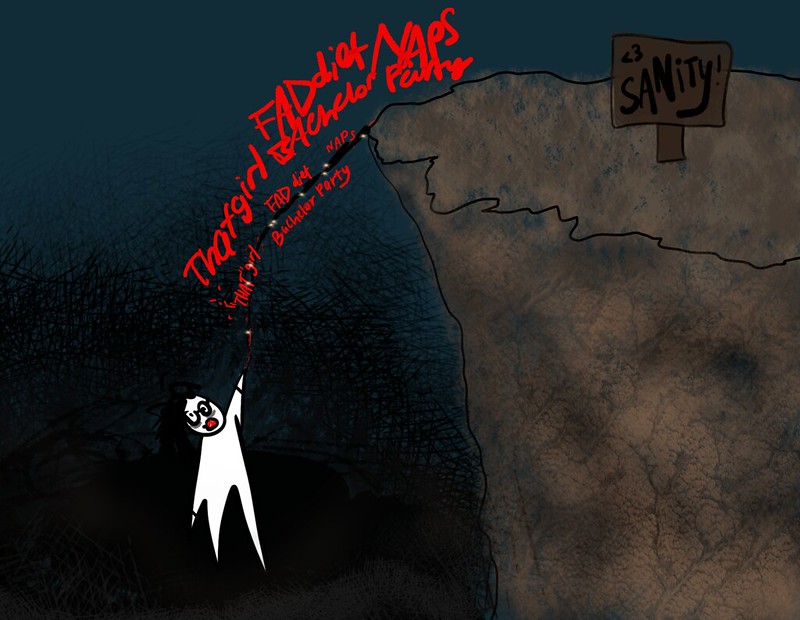The ultimate guide to mastering naps, beauty, love and productivity
Exhausted student is dependent on often ineffective solutions as a lifeline.
May 24, 2022
Mastering the nine-minute nap was the daunting task I vowed to overcome this school year. Between 11:00 p.m. and 1:00 a.m., I’m bewitched with dizzying spells of mental exhaustion. The tantalizing lull of simply giving up and sleeping steadily drags me down the summit of procrastinated assignments, and I’m sure that a quick nap will cause my chronic lack of motivation to vaporize, my weeks of sleep loss to recede and the sprinting time to halt.
Yet when I attempt to push aside my work for a nap, it is as if something is dislodged from my mountain of work, and all the accumulated stress breaks free and cascades into my mind. Anxiety from not being able to finish my work pummels me, and my formerly sluggish mind is racing. Before I know it, my nine-minute timer goes off, jolting me from my anxious half-awake state. I’ve gotten no more sleep and lost nine minutes to an unrestful break. It’s now between 11:09 p.m. and 1:09 a.m., but I’m back to square one.
Retrospectively, my dependence on these fleeting moments of rest to be a panacea is laughable. I’m not just referring to my power naps though. People have often relied on quick fixes to pull them out of hardships as they leave time to do more, more efficiently. Sayings such as “A good night’s rest solves everything” or “lost time is never found again” have been espoused by society and especially by our parents. But when the chase for productivity fails and leaves mental slumps that result in continuous dialogues like, “I’m really not feeling it right now. I’ll stop and I’m sure I’ll be fine tomorrow,” when do these strings of “tomorrows” become days, weeks, then months?
The prospect of power naps with its science that promises increased focus and energy aren’t the only things that entice people. Short-period solutions are just simply the rage. If I’m presented with two solutions to a problem, I’m naturally more inclined to choose the quicker option. But humanity’s obsession with quick fixes has led to dire effects, manifesting in the form of fad diets.
While the modern fad dieting gained popular momentum in the 1930s with trends such as the “Hollywood Diet” (claiming to cut down 10 pounds in just 48 hours!!!!), the history of such eating habits can be traced back centuries. Jamie Pronschinske, a registered dietician, states that “Fad diets are attractive because they promise something everyone wants: an easy and quick way to lose a lot of weight.”
Already, I sense a larger problem with Pronschinske’s claim that weight loss is universally coveted. And that easy generalization may account for the drastic means people have historically taken to cut down their figures. William the Conqueror was born in 1028, and for a portion of his life relied on a liquid diet, or rather an alcohol diet to lose weight. Nearly a millennium later in the 1960s, the Drinking Man’s Diet was introduced, another alcohol-centered diet with the addition of “masculine” food, namely meat, to accompany the drinks.
Liquid diets, now relabeled as cleanses and detoxes, continue to dominate food trends. They are advertised as a healthy and rejuvenating method to flush out our body’s toxins. And although all the vegetables and hard-to-pronounce bacteria packed into small bottles are possibly absolutely life-changing and could heal all my ailments, that’s all it is: vegetables and whatever else. The restrictive manner of these diets promises quick weight loss and invigorated health at the expense of strict rules and limited food freedom. All these factors combined, while under a disguise of good health, seem to border the traits of disordered eating behavior.
I’m not at all asserting that the green juice you purchase after a weekend yoga class is indicative of an eating disorder. But the heavily advertised rapid weight loss options open up the avenue of further diet restricting, especially when directed toward impressionable audiences.
Another recent phenomenon showcasing quick self-improvement was the rise of the social media trend, the “that” girl figure. “That” girl rose to become the face of productivity on social media. She begins her rigorous day and checks off everything from her to-do list. She doesn’t bounce back from hardships because her strict schedule doesn’t allow for any hardships. She even posts tutorials on her TikTok and Instagram, eager to help others out on how to become just like her.
Watching creators who brand themselves as “that” girl, I may conclude that the secret to their mesmerizing lives is the strict schedule they created and the discipline along with which they carry themselves (and that necessary cup of coffee).
You could argue that while the life of “that” girl seems unattainable, her presence alone isn’t harmful. Rather, having her as a figure of inspiration is motivation to get your life together, and perhaps one day, you could like a life akin to hers. Yes, perhaps her lifestyle is a bit unreasonable for mundane people, but she’s someone to strive to be like. Why not, right? Who doesn’t want to miraculously finish every task with spare time to focus on themselves? Given the rigorous lifestyle of the social media archetype, a nine-minute nap for her is likely seen as efficient rather than restraining. For students, having such a schedule must seem like a utopia.
But isn’t the essence of perpetuating unattainable standards harmful? For example, if we applied this logic to beauty standards, we run into a more tangible problem. Modern beauty standards are dominated with eurocentric ideals, and the desired body shape is ever-changing.
But what’s the harm, right? These standards may seem unattainable, but their presence alone isn’t harmful. They are what people strive to be.
I hope that this sounds a bit more alarming now, so is it very hard to believe that unrealistic lifestyles could produce similar insecurities?
Reeling us back to the detriments of productivity culture, I’d like to bring us to the next logical example after “that” girl: bachelor parties. These parties are practically a rite of passage for soon-to-be-married people—a final hurrah before “being chained down … for the rest of their lives,” and a homage to their single lives (were they even considered single?). Sometimes, these celebrations include bars and strip clubs.
It is as if these parties are a last indulgence before the trials of a productive and faithful marriage. These pre-married people are able to release all of their potential temptations in one night, a notably short time in preparation for a (hopefully?) long union. But sometimes, these soon-to-be grooms let a bit of infidelity leak.
“I don’t think a third is an outrageous number by any means,” clinical sexologist and psychotherapist Dr. Carlen Costa said, when referring to the number of cheating grooms at bachelor parties. Again, productivity culture fails at the hands of short-term fixes.
I’m going to assume that most of you haven’t had a bachelor party thrown in your name yet, so bachelor parties are most likely not what you immediately imagine as fast solutions. Instead, we have other forms of short-term fixes, found right on our campus at Dougherty. We students are limited to 15 minutes in the Wellness Center during class time. I get it, the time limit is to prevent missing too much class time while giving us an opportunity to escape, even if for just a bit. I can’t really advocate for a longer stay, as I think that I would run into a similar situation to my unsuccessful naps: fearing that my obligations would build up after missing out on essential learning. But still, I want to acknowledge that 15 minutes are likely not enough to cure many mental stressors. Still, the fact that 15 minutes is all that we can be afforded during school hours should affirm the difficulty of finding and committing to effective, long-term solutions.
I find that I am still caught in this cycle of relying on short-term solutions: nine-minute naps and whatever else that promises me results for only a small fraction of my time. But still, I think that I’ve come to the acceptance that there isn’t anything intrinsically wrong with me for being stuck like this. Quick but ineffective solutions appear attractive, and other times, certain solutions aren’t even necessarily a waste of our time, but rather we didn’t take enough time to fully reap the benefits. Other times, life just gets so overwhelmingly busy that committing to time-consuming programs of self-improvement causes more fear than growth.
Unfortunately, this article does not really provide a cure. I clearly haven’t found one, or you would have already seen me restored in a quick nine minutes. But rather, I want to offer the good-old reassurance that you are not alone. In a world full of productivity tips, videos of “how to become ‘that’ girl,” and billionaire daily routines, the commodity of motivation and productivity sometimes only drags us down instead of pushing us to become the advertised “best version of ourselves.”
I know that you likely have a seemingly insurmountable peak of things that tower over you, and that perhaps, it feels as if just the fear of wasting time alone can tip it over, crashing over you. It’s absolutely terrifying, I’m sure.
But while I am lacking a solution for you, I can offer absolute certainty that it is okay. It’s okay to not be able to instantly rebound, it’s okay that you need more time than you think you have. So stop pummeling yourself each time you feel as though you can’t keep up. Even if you sprint, only to fall behind the idealistic videos of wonderfully productive people, you’re not running late.
Football coach Bill Courtney said, “In the marathon of life, there is no finish line.” But for all our sakes, I hope there is, somewhere along the path at least—and I don’t mean for this to be a morbid reference to death. I’m not much of an athlete myself, but as I understand it, runners don’t just stop moving after finishing a race; they have to cool down to prevent injuries. So I hope that once we cross that finish line, we are granted our much-deserved cool down. Perhaps that’s not in sight yet, and all you’re offered are a handful of minutes to catch your breath: a transitory nine minutes that feels like one. Still, I hold on to the belief that we will eventually have more. We will bury ourselves with deep, blissful sleep; we will move as though we are not chased down by internet productivity trends.
Just as I believe that there is a finish line in our lives, I believe that there are multiple. And because I am not much of an athlete, walking a few of these races doesn’t sound too bad.






